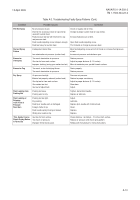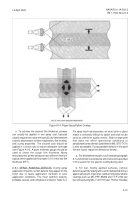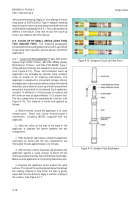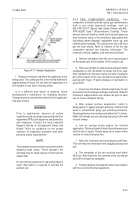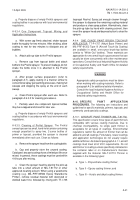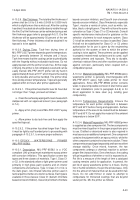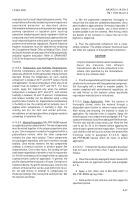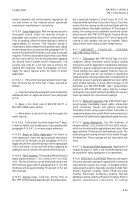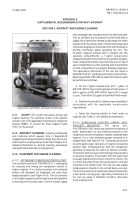TM-1-1500-344-23-2 - Page 193 of 240
A-23
NAVAIR 01-1A-509-2
TM 1-1500-344-23-2
15 April 2009
A-10.2.8. Film Thickness. The total dry film thickness of
primer shall be 0.6 to 0.9 mils (0.0006 to 0.0009 inch)
which is slightly more than a mist coat. After the coating
has dried, the substrate should be barely visible through
the film. Dry film thickness can be estimated using a wet
film thickness gage (refer to paragraph A-5.7). Dry film
thickness will be approximately 50 percent of the wet
film thickness. Primer thickness shall be doubled if no
topcoat is to be applied.
A-10.2.9. Drying Time. Tack-free drying time of
MIL-PRF-23377 primer depends upon the temperature,
but is generally between 30 minutes and 2 hours.
Tack-free means that the coating can be touched lightly
with the fingertip without noticeable tackiness. Do not
apply topcoat until the primer is tack-free. At this stage
of drying, the primer is not completely cured and can be
easily marred. MIL-PRF-23377 primer will dry hard in
approximately 8 hours at 70
°
F, which means the coating
is fairly durable and can be handled. The primer dries
more slowly at lower temperatures. Topcoat is generally
applied within 24 hours after primer application.
A-10.2.9.1. If the primer has dried for over 24 hours but
not longer than 7 days, proceed as follows:
a. Clean the surface by wiping with clean cheesecloth
dampened with an approved solvent (see paragraph
A-7.4).
b. Apply a thin (mist) coat of MIL-PRF-23377 epoxy
primer.
c. Allow primer to dry tack-free and then apply the
specified topcoat.
A-10.2.9.2. If the primer has dried longer than 7 days,
it must be lightly scuff sanded prior to proceeding with
paragraph A-10.2.9.1, to ensure proper adhesion.
A-10.3. EPOXY
WATERBORNE
PRIMER
(MIL-PRF-85582).
A-10.3.1. Description. MIL-PRF-85582 is a VOC
compliant (340 g/l maximum) waterborne epoxy primer
with corrosion inhibitors. This specification covers two
types and three classes of materials. Type I, Class C1
or C2, is the standard yellow or light green primer used
primarily in high gloss paint systems and on interior
components and surfaces. Type II, Class C1 or C2, is
the dark green, low infrared reflective primer used in
tactical paint schemes or exterior surfaces. Each type is
available in three classes: Class C1 (barium chromate
based corrosion inhibitor), Class C2 (strontium chromate
based corrosion inhibitor), and Class N (non-chromate
based corrosion inhibitor). Class N materials, especially
Type I, may be a variety of colors, such as white, tan,
blue, black, or bright green. They will not have the same
coloration as Type I, Class C1 or C2 materials. Consult
specific maintenance instructions for guidance on the
selection of primers for each weapons system. Class
C1 shall be selected when no class is specified. Class
N shall not be substituted for Class C1 or C2 unless
authorization for its use is given by the engineering
authority for the system or item to which the primer
coating is to be applied. These primers can be applied
to properly treated metal surfaces and to cured, scuff
sanded primers and topcoats. They dry to durable,
chemical resistant films and offer excellent protection
against corrosion, particularly when coupled with a
compatible topcoat.
A-10.3.2. Material Compatibility. MIL-PRF-85582 epoxy
waterborne primer is generally interchangeable with
MIL-PRF-23377 epoxy high solids primer for most
applications. Since MIL-PRF-85582 primer contains
water, to prevent possible corrosion it shall not be used
for wet installations (refer to paragraph A-4.8) or for
direct application to bare steel (e.g. landing gear
components).
A-10.3.3. Temperature Requirements. Ensure the
temperature for each primer component is between
60
°
F and 90
°
F before mixing and application. Surface
temperature of the area to be coated must be between
55
°
F and 95
°
F. Do not apply this material if the ambient
temperature is below 55
°
F.
A-10.3.4. Material Preparation. MIL-PRF-85582 primer
is supplied as a two component kit. The two components
must be mixed together in the proper proportions prior
to use. Distilled or deionized water is also required in
most cases as an additional component. One component
contains the pigment within an epoxy vehicle, while the
other component contains the clear resin solution. These
components are packaged separately and have excellent
storage stability. Once mixed, however, the two
components undergo a chemical reaction to achieve
proper film characteristics. Over a few hours, the coating
will gel regardless of whether or not it is exposed to air.
Pot life is a measure of the length of time a catalyzed
coating remains useful for application. In general, the
pot life of epoxy waterborne primer is 4 hours. During
hot or humid conditions, the pot life will decrease. Only
mix the amount of material that can be used within two
hours. Do not add thinner or water to attempt to
compensate for thickened coatings that are beyond
useful pot life. Mix the primer as follows:
Back to Top

